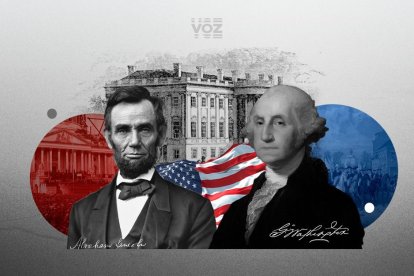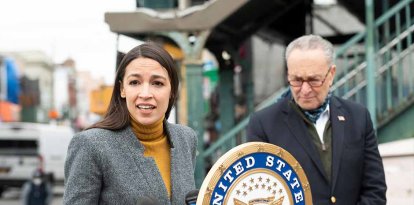The history behind Presidents' Day: From Washington's birthday to the modern holiday
Every third Monday in February, the United States celebrates its heads of state, with the tradition dating back to 1880.

Diseño Voz Media
The presidents of the United States are world-renowned figures given their strong media exposure and their importance to global geopolitics. Even ChatGPT placed two of them among the 20 most famous people in history. Although none of them enjoy full approval from citizens, Americans still have one day a year to recognize them. This is the history of Presidents' Day, which takes place every third Monday in February.
For much of the 19th century, many states celebrated George Washington's birthday on Feb. 22. The first president is one of the most popular in almost all surveys among historians and the general public. The man who refused to be king died in 1799 and, since then, his birth was a reason for celebration in many corners of the country.
The date began to be formalized in the 1870s, when Senator Stephen Wallace Dorsey (R-Ark.) first promoted the measure that in 1879 would be signed into law by President Rutherford B. Hayes. The first holiday took place in 1880. Although in principle it only applied to the District of Columbia, the celebration spread to the entire country in 1895, and then every Feb. 22, the birthday of the first president began to be celebrated.
Washington's birthday was the first holiday honoring an individual citizen and had joined the four other national holidays of the time: Christmas, New Year's, Fourth of July and Thanksgiving.
Everything changed in the 20th century with the Uniform Holiday Monday Act, promoted by Congressman Robert McClory (R-Ill.). This legislation was signed into law by President Richard Nixon and changed the holiday calendar. It moved all holidays to Mondays, which inevitably affected the day commemorating the first president's birthday. According to Britannica, “The change was designed to schedule certain holidays so that workers had a number of long weekends throughout the year.”
As Congress debated the bill, lawmakers proposed unifying Washington and Abraham Lincoln's birthdays, the latter being Feb. 12, into a holiday celebrating both. McClory even proposed the name Presidents' Day. Although the change ultimately did not succeed, the date was modified to the third Monday in February.
Why is the holiday known as Presidents' Day?
It did not take long for McClory's proposal to gain popularity among Americans, mainly among businessmen in the tourism sector. Their marketers wasted no time and, faster than Roadrunner escaping Wile E. Coyote, the third Monday in February was rebranded as Presidents' Day.
This name was adopted by many states around 2000. By the new millennium, 25 of the 50 states had changed the name of the holiday to Presidents' Day. Some even took the opportunity to kill two birds with one stone. For example, Arkansas celebrates both Washington and civil rights activist Daisy Gatson Bates, while Alabama does the same for Thomas Jefferson, whose birthday is in April.
According to The History Channel, “Washington and Lincoln still remain the two most recognized leaders, but Presidents' Day is now popularly seen as a day to recognize the lives and achievements of all of America’s chief executives.”
In its modern form, it is a day for citizens to organize celebrations throughout the United States honoring the memory of leaders of the present and past. Some states require their public schools to spend the days leading up to Presidents' Day teaching students about the achievements of heads of state.
One by one, all the presidents of the United States
As a tribute, these are the 45 men who have held the office of president of the United States:
- George Washington (1789-1797) No party
- John Adams (1797–1801) Federalist
- Thomas Jefferson (1801-1809) Democrat – Republican
- James Madison (1809-1817) Democrat – Republican
- James Monroe (1817-1825) Democrat – Republican
- John Quincy Adams (1825 -1829) Democrat – Republican
- Andrew Jackson (1829-1837) Democrat
- Martin Van Buren (1837-1841) Democrat
- William Henry Harrison (1841) Whig
- John Tyler (1841-1845) Whig
- James K. Polk (1845-1849) Democrat
- Zachary Taylor (1849-1850) Whig
- Millard Fillmore (1850-1853) Whig
- Franklin Pierce (1853-1857) Democrat
- James Buchanan (1857-1861) Democrat
- Abraham Lincoln (1861-1865) Republican
- Andrew Johnson (1865-1869) Democrat
- Ulysses S. Grant (1869-1877) Republican
- Rutherford B. Hayes (1877-1881) Republican
- James A. Garfield (1881) Republican
- Chester A. Artur (1881-1885) Republican
- Grover Cleveland (1885-1889) Democrat
- Benjamin Harrison (1889-1893) Republican
- Grover Cleveland (1893-1897) Democrat
- William McKinley (1897-1901) Republican
- Theodore Roosevelt (1901-1909) Republican
- William H. Taft (1909-1913) Republican
- Woodrow Wilson (1913-1921) Democrat
- Warren G. Harding (1921-1923) Republican
- Calvin Coolidge (1923-1929) Republican
- Herbert C. Hoover (1929-1933) Republican
- Franklin D. Roosevelt (1933-1945) Democrat
- Harry S. Truman (1945-1953) Democrat
- Dwight D. Eisenhower (1953-1961) Republican
- John F. Kennedy (1961-1963) Democrat
- Lyndon B. Johnson (1963-1969) Democrat
- Richard M. Nixon (1969-1974) Republican
- Gerald R. Ford (1974-1977) Republican
- Jimmy Carter (1977-1981) Democrat
- Ronald Reagan (1981-1989) Republican
- George H.W. Bush (1989-1993) Republican
- William J. Clinton (1993-2001) Democrat
- George W. Bush (2001-2009) Republican
- Barack Obama (2009-2017) Democrat
- Donald Trump (2017-2021) Republican
- Joseph Biden, Jr. (2021-2025) Democrat
- Donald Trump (2025-present) Republican
RECOMMENDATION





















